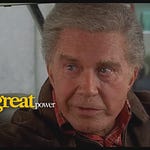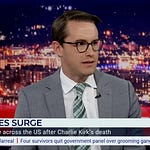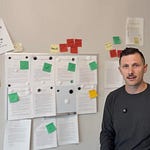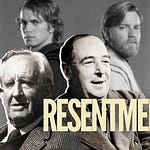Geeky Stoics is all about highlighting the wisdom found in our favorite movies, shows, and books. We bring together philosophy and pop culture to try and help you get the most out of your time spent in other worlds, those works of fiction. Uncle Iroh of Avatar: The Last Airbender is one of my top favorite characters for wisdom. He’s chock full of maxims and proverbs and what you might call fortune cookie philosophy, but it works remarkably well. I’ve written down several of his sayings in that show for use in my own life.
In the new live-action adaptation of Airbender, Uncle Iroh is reflecting on the suffering of his nephew, Prince Zuko, who has been banished from home for not being as cutthroat and ruthless as his father would like him to be. Zuko tries very hard to impress his father, but Zuko has a big heart, and it makes the task impossible.
Zuko lives his life day to day not being his true self, not letting that heart show. The reason is simple. Showing his heart got him hurt very badly when his father laid fire to half of his face as a punishment for it.
It breaks Iroh’s heart. Zuko should not have to wear the mask of a brute to make his father proud. That is a burden no child should have to carry.
So Iroh begins to speak about the power of Masks. Here is what he says:
It's amazing how far we'll go to hide our true selves from the world.
Perhaps it's because we don't want people to know how much they really mean to us. Which is funny.
Because the truth is, we would do anything for them.
We'd travel incredible distances, risk our lives, even fight monsters.
But I suppose it can be scary to admit you need people.
Some might see that as a weakness, a liability.
After all, what greater pain is there than losing someone you love?
Or worse, finding out someone you love has left you behind.
I guess that's why we feel the need to hide away and protect ourselves.
So we put on a mask.
It's not hard to understand why.
What's hard is knowing that sometimes, the mask is who we really are.
What masks do you wear? I wear a few.
Not all are bad. Some are good.
When I do TV or public speaking I put on the mask of a confident person. It’s necessary because I am terrified. The mask gives me some needed strength.
When I am with my daughter I wear the “Dad Mask”. As Dad, I don’t overburden her with my problems, I don’t share what’s not in the bank account, I don’t overplay the fact that 75% of the time I don’t know what to do about anything……because she needs the feeling of security. It takes courage to wear that mask as a parent. There will be times when that mask needs to come off, and that will require bravery as well.
We play certain roles to stay alive or make it in this world.
My hope is that by reading this email today, you’ll begin to think about what masks play a role in your life, and be able to at least name them. When you are conscious of what they are, and when you put them on, you’ll have better control over their role in your life. But that does take reflection. Take that time today.
Housekeeping…
As you’re reading this I am on a flight to the other side of the world for work. I’ll be in Dubai through Friday, so I wanted to make sure you had this before my departure. In this email you’ll find an excerpt from my book, How The Force Can Fix The World, from chapter two on Empathy and how Star Wars teaches us about it. The book is a few years old now, but I find with this newsletter community we are adding new people every day who don’t know about it. Maybe you’ve read it already and need a refresher on what Star Wars has to say about masks and their power in our lives.
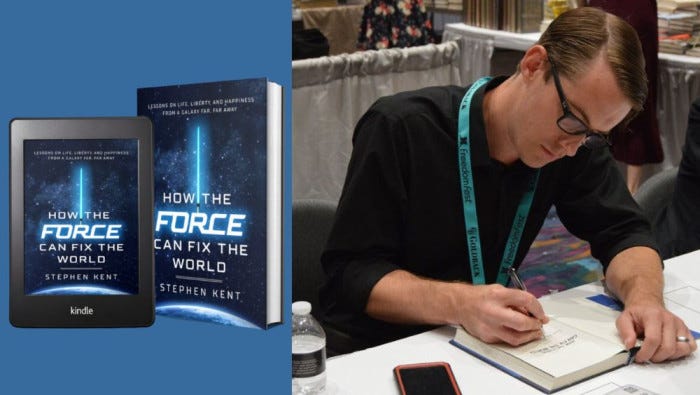
Excerpt: How The Force Can Fix The World
Wearing a mask
Star Wars has a handful of traditions and themes that you can trace throughout its entire cinematic history. Whether it’s the hero who wears white or the villain dressed in black, or the use of music to signal the virtue or evil of any given character, visual symbolism is essential to storytelling in a galaxy far far away. One of those symbols is masks.
The original trilogy, starting in 1977 with Episode IV: A New Hope and continuing with The Empire Strikes Back and Return of the Jedi, was mostly made iconic not by its heroes, but by the masked malefactor Darth Vader. Fans were made to wonder for many years what was beneath the mask, what was the full story of this man who Obi-Wan derided as being “more machine now than man?”
Beginning in The Empire Strikes Back, we start to understand. Vader was once a man named Anakin Skywalker, he turned to the dark side and in so doing lost pieces of his humanity along the way. Still, we don’t know what literally lies beneath. While Luke Skywalker is training to be a Jedi on the swampy world of Dagobah with the pint-sized Master Yoda, he experiences a vision of sorts where he battles Vader and wins. When Vader falls headless to the ground, his mask bursts open and a face is revealed. It’s Luke’s face.
Symbolic, of course. We know from this vision Luke experienced that the truth of Vader’s identity isn’t really the point, it’s that Luke too could become like Vader if he’s not careful with the Force. The mask allows anyone watching Star Wars to put themselves inside the black suit of robotic armor and consider, “This could be me.”
Episode VII: The Force Awakens does something similar. The movie's three main characters are all introduced with their faces covered by masks. For the introduction of Rey, she is masked on the desert planet of Jakku, rummaging through a downed Star Destroyer for scrap parts. We quickly learn she’s all alone, abandoned there by a family whom she barely remembers. Finn is first introduced as a Stormtrooper. He serves in the ranks of the neo-Imperial First Order, a fighting force composed of kidnapped children from all around the galaxy, brainwashed and raised to fight. Finn is snapped out of his brainwashing by a violent trauma. One of his comrades is struck down in battle, then reaches out with a blood-soaked hand, defacing Finn’s mask.
Once he is alone, the Stormtrooper known first by his dehumanizing call sign FN-2187, rips his mask off. What we see is a frightened and upset young man. It’s the first time Star Wars audiences have ever had a real look at the human being inside that famous armor.
Then of course there’s Kylo Ren.
Masks by their nature are hiding something. In some cases it’s something the wearer doesn’t want you to see — ugliness, shame or maybe truth. Sometimes it’s a thing the wearer themselves don’t want to see, or maybe want to forget. In other instances, the mask can itself be a new identity to fill the void created by losing your sense of self and becoming something new. One or all of these things can be true at once. We all wear masks, don’t we? Probably not in the literal sense, but we’re masters of covering up how we feel or who we really are by creating alternate personas to navigate different situations. My wife likes to joke about her “customer service voice” as someone who has worked in the service industry for over a decade. There’s a certain elevation of the voice and the use of a manufactured smile that comes along with certain types of jobs. You probably know of a few.
Sometimes we take on harsh masks as well, to avoid vulnerability and opening ourselves up to feeling hurt. A child acting out at school and being cruel to others can be a mask. Sit them down and ask a few questions, and you may uncover a great deal of pain and unhappiness that they’re covering up with hostility and faux shows of strength.
Masks behind bars
Bishop Omar Jahwar was a spiritual activist and community leader in the Dallas-Fort Worth area before he passed away in 2021 due to complications related to COVID-19. He was the Presiding Bishop of the Kingdom Covenant of Churches and helped found an organization called Urban Specialists that works to stop violence on the streets of American cities. Gang violence is the primary focus of Omar, who takes a hands-on approach to knowing competing gang leaders in a city and then meets with them to try and understand them better. Part of Omar’s belief and the logic of Urban Specialists is that while urban gangs tend to stumble into cycles of perpetual violence, the vast majority of members within these gangs would like to not die violent deaths. They want to live, and in many cases they’d like to have new lives that don’t involve gangs at all. So his approach is kind of radical. There are plenty of nonprofits dedicated to getting people, mostly young men, out of gangs but there were none focused on simply making the enterprise less violent.
Omar got his start counseling men behind bars who were serving time for all sorts of crime and then aligning themselves with prison gangs. It was there he had this kind of revelation, that while gangs and their foot soldiers are indeed scary to the general public, these are mostly desperate young men trying to survive. In America’s most violent neighborhoods, gangs fill a void for destitute families where they offer both income for young men of the house, and protection by way of affiliation with the gang. For young men lacking stable families to support, the embrace of gangs stands in for the safety that family would normally provide. The cost however, is high. Bloodshed is almost always involved.
I spoke to Omar in April 2020, and he told me that what he realized when meeting with these men was that they were one person with their gang and another person with him. They had bifurcated their own identities, adopting a sense of self tied to the gang and another that was their private, more authentic self. The trouble is that identities war inside of us for control of the entire being, and after enough compromise, enough unforgettable evil, enough killing...the mask that a young man wears to receive security from a gang can consume him entirely.
The culture of Star Wars’ dark side practitioners, the Sith, is eerily similar. When a person commits to the life of a Sith, they take on a new name that begins with “Darth” and in most cases the next part is assigned to them by a master. Their old self is to die with their old name, they cease to be “Anakin Skywalker” for example, and become Darth Vader. When Vader is confronted by his son Luke in Episode VI: Return of the Jedi, and addressed by the name Anakin Skywalker, it elicits quite the physical reaction. Vader whiles around, pointing a lightsaber to Luke’s chest, “That name no longer has any meaning for me.”
This is exactly the kind of mentality Omar has seen all too frequently with young men serving time. A combination of disassociation and hostility to an outstretched hand. The mask they’ve chosen is protection, from perceived threats both physical and spiritual. Omar’s job is to try and see past it, help them remove it and if he can — and show them the way back to the light.





